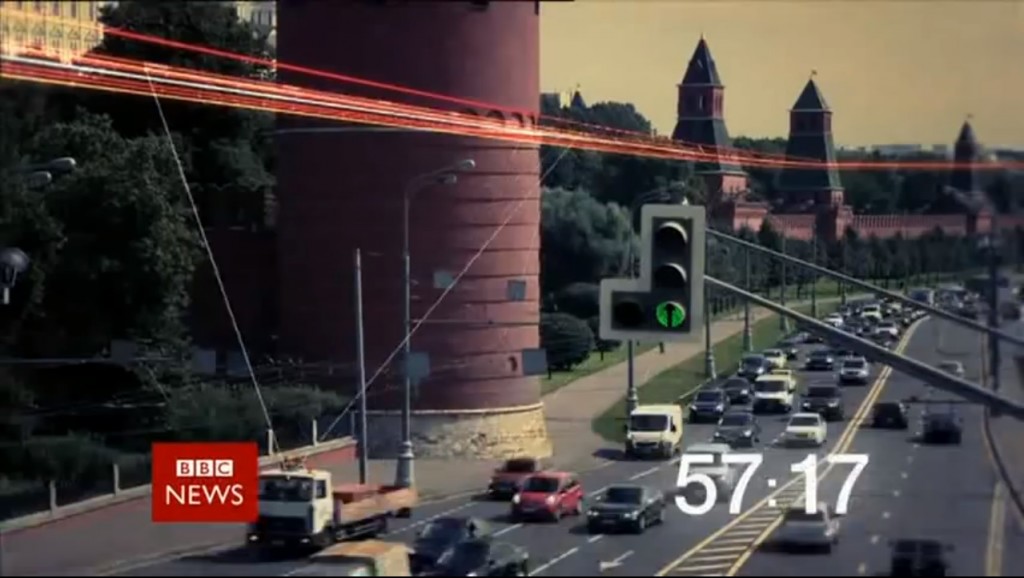Most shortwave radio listeners are familiar with interval signals–those ditties that precede a shortwave radio broadcast–indicating a specific broadcast frequency and that a broadcast is about to begin.
On television, there’s really no need for an interval signal: channel selection is accurate and schedules are ubiquitous. Indeed, there’s no guess work involved at all. Tune to channel 3 at 6:00, and you know the evening news awaits you.
Still, many television news services around the world provide a visual-plus-aural countdown for their viewers which, in essence, serves the same purposes as an interval signal. As on the radio, it’s a build up…a “get ready, here comes the news” statement that’s separate from the title sequence. The most notable example I know of is the BBC’s television countdown, which, depending on timing, might count down for one minute–or even for several minutes on satellite feeds.
Here is the BBC’s latest (2013) countdown:
News agencies in the US, alas, never bother with a one-minute countdown to the hour because this is profitable time that can be filled with a sponsors’ advertising.
Perhaps that why I’ve always been a fan of the BBC, and even proudly payed my TV tax when I lived in Britain. The BBC, in general, represented a refuge from other TV mass media and the accompanying news network over-stimulus. While I still have many criticisms of the BBC–indeed, they’re stumbling now–I nonetheless prefer this broadcaster to most TV news services stateside. [Of course, what I find most objectionable are the changes which could affect the integrity of the BBC World Service, now directly funded by the UK’s TV licensing fees instead of the Foreign Office.]
But I do enjoy this countdown.
If you share my appreciation for this “TV interval signal,” here are a few other examples starting with a compilation of BBC countdowns from 1999-2007 produced by a fan:
NBC News Special Report Countdown:
And if you can’t get enough of the BBC’s countdown montage, here’s a 10 minute filler version:
Will anyone else confess their love for a broadcaster’s countdown? Please comment!


In Cambodia, where I live, BBC World “runs” with a 10 MINUTES delay, so the countdown is always at 10 minutes past the hour, not on the hour! Do you know why?
Most likely for the ability to censor the programing Garry. When I use to work in Malaysia (turn of the century) BBC World TV & CNN International were both delayed by a few minutes. If any story came on critical of the Mahathir (Prime Minister at the time) Regime was on either channel the video pixelated and the audio was cut. Cheers, Mark
I like the countdown I only wish it were accurate, or even close. It’s often up to 10 seconds off.
Hi Dave, the inaccuracy in timing is likely due to the digital transmission path the BBC broadcast travels before it reaches you. Yes, what you’re watching can be several seconds delayed from when it actually left the BBC Central London studio.
For example here in Australia I am slightly different to the typical user in that I watch BBC World News directly off a BBC World HD feed circuit on Intelstat 19, but if I was to watch it on one of Australia’s cable or DTH satellite networks the signal would be a few seconds behind what I receive on my large C-Band dish.
For the typical viewer in Australia (viewing by our pay TV network Foxtel) this is the path of “jumps” the BBC World News broadcast takes to reach their television:
Jump 1 – BBC UK
Jump 2 – Signal fed by optical fibre across the Atlantic to the USA (5,600 km)
Jump 3 – Signal feed by optical fibre across the USA to a Intelsat uplink in the Napa Valley in California (4,680 km)
Jump 4 – Signal travels from the California uplink to Intelsat 19 (35,000 km)
Jump 5 – Signal travels from Intelsat 19 to the Foxtel receiving dish in Sydney (35,000 km)
Jump 6 – Signal travels from Foxtel uplink to Optus C1 satellite (35,000 km)
Jump 7 – Signal travels from Optus C1 to the viewer’s own home satellite dish (35,000 km)
So for the average Australian viewer the signal has travelled 150,280 km from the studio to the TV. The speed of light (the broadcast transmission speed) is about 300,000 km per second, but what slows the whole path down is digital processing and handling at each jump, re-encoding the signal to different digital formats, adding copy protection etc. etc. Basically, it may be better to think of the countdown as how long you have to boil the kettle and be back to the TV before the news starts rather than it being the same as an analogue radio station’s time pips which you could use to set your watch! 🙂
Very interesting Mark and it makes sense.
Still bothers me though. 🙁
Back in the dreamtime, about 60 years ago, they said that sitting next to your radio in Australia you would hear
Big Ben ( on the BBC) before the man in the street in London would hear it…
RNZI’s bird call, I think it is a Tui, gets my vote.